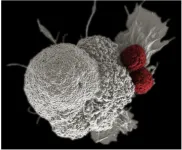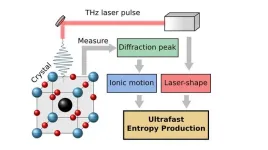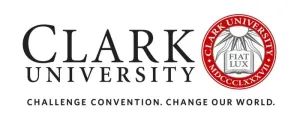(Press-News.org) Nasopharyngeal carcinoma (or NPC) is a rare type of cancer affecting the epithelial tissue of the nasopharynx, the upper part of the throat behind the nasal cavity. Among the three main subtypes of NPC, non-keratinizing undifferentiated squamous carcinoma is endemic to the regions of Southern China and Southeast Asia, with a strong association with Epstein-Barr virus (or EBV) infection. EBV, also known as human tumor virus, is a double-stranded DNA virus that is associated with various cancers, such as Burkitt lymphoma, T-cell lymphoma, and gastric cancer. EBV genomes mostly survive autonomously as episomes or extrachromosomal DNA (ecDNA) by attaching to the host chromosome in the nucleus. Most of the EBV genome is repressed by methylation of their DNA and thus expresses limited genes. However, once EBV infects a host, it targets the host heterochromatin (a condensed form of DNA) and activates many latent host and viral genes that promote tumor formation. 'Enhancer infestation' or the activation of repressed enhancers (DNA-regulatory elements that activate transcription of a gene or genes) in the host genome, is one of the many ways of host genome rewiring by EBV. Although EBV-host cell interactions have been studied in many EBV-associated cancers, the cross-species genomic interaction and consequent chromatin changes in NPC have not been demonstrated.
In a recent study published in Volume 102 of eBioMedicine on March 14, 2024, Professor Atsushi Kaneda from the Graduate School of Medicine, Chiba University, Japan, and Associate Professor Melissa Jane Fullwood from the School of Biological Sciences, Nanyang Technological University, Singapore (NTU Singapore), have attempted to fill this knowledge gap by conducting collaborative research with their colleagues and scientists from Kanazawa University and Hamamatsu University School of Medicine, Japan, and from Duke-NUS Medical School, Singapore.
Explaining the motivation behind this study, an enthusiastic Assoc Prof Fullwood explains, "I thought it would be very helpful if we could clarify the molecular mechanisms of cancer development and establish novel therapeutic strategies targeting not only resectable cancers but also intractable, metastatic, or recurrent cancers."
To undertake this examination, Dr. Harue Mizokami and colleagues conducted Hi-C, 4C-seq, CHIP-seq, and RNA-seq analyses to thoroughly understand the epigenomic rewiring and genetic dysregulation using C666-1 EBV (+)-NPC cell lines, NP69T immortalized nasopharyngeal epithelial cells, clinical NPC biopsy samples, and in vitro EBV infection in human EBV (-) cell lines HK1 and NPC-TW01.
In C666-1, it was observed that EBV genomes interacted with the host genome primarily in AT-rich, gene-poor regions, called the EBV-interacting regions or EBVIRs, that were located within the inactive B compartment of the host heterochromatin. Furthermore, using Hi-C and CHIP-seq, they found that the EBV ecDNA may relax the inactive B compartments by activating enhancers in NPC cells. Moreover, the identified EBVIRs displayed significantly higher levels of histone protein alterations compared to NP69T, confirming genome restructuring. The above findings were also validated in clinical NPC biopsy samples.
Moreover, aberrant enhancer activation or genome rewiring resulted in dysregulated gene expression. Hi-C analysis identified H3K4me3(+) as one of the main genes affected by the EBV-host epigenomic alterations. Confirming the above finding, RNA-seq analysis of NP69T and C666-1 cells found increased expression of 14 H3K4me3(+) genes in C666-1. EBVIRs altered the expressions of the target genes PLA2G4A, PTGS2, and CITED2 in NPC cells. Their upregulation contributed to the growth of cancer cells, while the knockdown of these genes showed a significant reduction of NPC cell growth.
Discussing the impact of these findings, a hopeful Prof. Kaneda surmises, "Our findings will generate interest and create awareness among people on the ability of a virus to epigenetically alter our body's cells and cause diseases such as cancer. Moreover, the elucidated epigenetic mechanisms of cancer development will enable the development of novel cancer therapeutic strategies other than genome target therapy."
In summary, the study provides important insights into the mechanisms of virus-mediated tumorigenesis and paves the way for the development of novel therapeutic strategies.
About Professor Atsushi Kaneda
Dr. Atsushi Kaneda is a Professor at the Department of Molecular Oncology, Graduate School of Medicine at Chiba University, Japan. He is also the Director of Health and Disease Omics Center at Chiba University. He has conducted the JST CREST project, and undertaken AMED cancer projects to clarify epigenomic alteration and tumorigenesis by environmental factors. Professor Kaneda's work focuses on epigenomic modifications and genetic aberrations that cause cancer. He has more than 230 publications to his credit.
About Associate Professor Melissa Jane Fullwood
Dr. Melissa Jane Fullwood is an Associate Professor in the School of Biological Sciences, Nanyang Technological University. Assoc Prof Fullwood’s work focuses on the 3D genome organization of DNA and RNA in cancer and Artificial Intelligence for investigating epigenomics and transcriptomics. She has conducted projects under the National Research Foundation (NRF) Fellowship, as well as received grants from AISG, Ministry of Education, and the National Medical Research Council. She has also participated in projects under the NRF CRP program. She has published 55 publications which have been cited more than 19,000 times.
END
Smart maneuver: Epstein-Barr virus hijacks host genome boosting nasopharyngeal carcinoma
Researchers unravel the mechanisms of Epstein-Barr virus (EBV) and host chromatin interactions in nasopharyngeal cancer cells
2024-03-26
ELSE PRESS RELEASES FROM THIS DATE:
New method to measure entropy production on the nanoscale
2024-03-26
Entropy, the amount of molecular disorder, is produced in several systems but cannot be measured directly. An equation developed by researchers at Chalmers University of Technology and Heinrich Heine University Düsseldorf, now sheds new light on how entropy is produced on a very short time scale in laser excited materials.
“New computational models give us new research opportunities. Extending thermodynamics for ultrashort excitations will provide novel insights into how materials function on the nanoscale,” says Matthias Geilhufe, Assistant Professor ...
Scientists on the hunt for evidence of quantum gravity’s existence at the South Pole
2024-03-26
Scientists on the hunt for evidence of quantum gravity’s existence at the South Pole
University of Copenhagen team contributes to an Antarctic large-scale experiment striving to find out if gravity also exists at the quantum level. An extraordinary particle able to travel undisturbed through space seems to hold the answer.
Several thousand sensors distributed over a square kilometer near the South Pole are tasked with answering one of the large outstanding questions in physics: does quantum gravity exist? ...
New roadmap to prevent pandemics centers on protecting biodiversity
2024-03-26
ITHACA, N.Y. – An international team of 25 scientists has proposed a roadmap for how to prevent the next pandemic by conserving natural areas and promoting biodiversity, thereby providing animals with enough food, safe havens and distance to limit contact and the transfer of pathogens to humans.
Pandemics begin when disease-harboring animals, such as bats, come in close proximity with people, livestock or other animals and pass on new pathogens. Viruses such as SARS-CoV-2, SARS-CoV-1, Nipah, Hendra and possibly Ebola have all fatally spilled over from bats to humans, ...
New maps help decision-makers factor albedo into tree-planting decisions
2024-03-26
Arlington, VA – As efforts to restore tree cover accelerate to help avoid runaway climate change, a new study highlights how restoring tree cover can, in some locations, heat up the Earth rather than cool it by affecting how much sunlight the surface reflects (i.e. “the albedo").
This new study by researchers at Clark University in the United States alongside scientists from The Nature Conservancy (TNC) and ETH-Zurich, published today in the journal Nature Communications, provides a global analysis of where restoration of tree cover is most effective at cooling the global climate system, considering ...
The construction of visual attention highlighted at the neuronal level
2024-03-26
In a world inundated with a constant stream of new information—notifications, ads, emails, news—we often struggle to prevent our attention from being constantly hijacked by external events. But is it truly within our power to filter and select our perceptions? And why do we find ourselves so easily distracted?
“Exogenous attention, the cognitive process that allows a salient visual stimulus to impose itself on us, is automatic. When a colleague walks past our desk, our attention is diverted from our computer screen despite ourselves,” explains Tal Seidel Malkinson (University of Lorraine), ...
Spielberg was right: Triceratops teamed up
2024-03-26
Actually, the team from Naturalis Biodiversity Center in the Netherlands was looking for a Tyrannosaurus, that summer of 2013 in Wyoming. Instead, they found a Triceratops: the famous dinosaur with the three horns and the large neck frill. And then they found another one. And another one. And more. The dig turned into a project that would last for more than ten years.
All in all, they dug up 1200 bones and bone fragments, of at least five individuals. A team of professional and volunteer paleontologists ...
Young adults with migraine, other nontraditional risk factors may have higher stroke risk
2024-03-26
Research Highlights:
Nontraditional risk factors for stroke were significantly associated with the development of strokes in adults younger than ages 35 to 45.
Migraine was the most important nontraditional risk factor for stroke among both men and women, according to the study of adults in Colorado.
Embargoed until 4 a.m. CT/5 a.m. ET Tuesday, March 26, 2024
DALLAS, March 26, 2024 — Adults younger than 35- to 45-years old may have a higher risk of developing a stroke from nontraditional risk factors ...
New data offer reality check on blood-based colorectal cancer screening
2024-03-26
Bethesda, MD (March 26, 2024) – Modeling studies and expert consensus published today in the journals Gastroenterology and Clinical Gastroenterology and Hepatology shed new light on the promise and peril of liquid biopsy (blood tests) for colorectal cancer (CRC) screening that are currently in development.
“Based on their current characteristics, blood tests should not be recommended to replace established colorectal cancer screening tests, since blood tests are neither as effective or cost-effective, ...
Virginia Tech study considers ways to increase accessibility for all wildlife enthusiasts
2024-03-26
One in three birders experiences accessibility challenges to participation in birding, according to Virginia Tech researchers Emily Sinkular and Ashley Dayer.
“I like to think of our research as blending together two previously unconnected fields: disability studies and wildlife recreation,” said Sinkular, a Ph.D. student and lead author of the study published March 26 in the journal Human Dimensions and Wildlife. “There’s been quite a lot of research on disability and lots of research on birding, but very few researchers have combined these two topics together.”
The ...
From autism to Alzheimer’s: A large-scale animal study links brain pH changes to wide-ranging cognitive issues
2024-03-26
A global collaborative research group comprising 131 researchers from 105 laboratories across seven countries announces a groundbreaking research paper submitted to eLife. Titled "Large-scale Animal Model Study Uncovers Altered Brain pH and Lactate Levels as a Transdiagnostic Endophenotype of Neuropsychiatric Disorders Involving Cognitive Impairment," the study identifies brain energy metabolism dysfunction leading to altered pH and lactate levels as common hallmarks in numerous animal models of neuropsychiatric and neurodegenerative disorders, such as intellectual disability, autism spectrum disorders, schizophrenia, bipolar disorder, depressive disorders, and Alzheimer’s ...
LAST 30 PRESS RELEASES:
Injectable breast ‘implant’ offers alternative to traditional surgeries
Neuroscientists devise formulas to measure multilingualism
New prostate cancer trial seeks to reduce toxicity without sacrificing efficacy
Geometry shapes life
A CRISPR screen reveals many previously unrecognized genes required for brain development and a new neurodevelopmental disorder
Hot flush treatment has anti-breast cancer activity, study finds
Securing AI systems against growing cybersecurity threats
Longest observation of an active solar region
Why nail-biting, procrastination and other self-sabotaging behaviors are rooted in survival instincts
Regional variations in mechanical properties of porcine leptomeninges
Artificial empathy in therapy and healthcare: advancements in interpersonal interaction technologies
Why some brains switch gears more efficiently than others
UVA’s Jundong Li wins ICDM’S 2025 Tao Li Award for data mining, machine learning
UVA’s low-power, high-performance computer power player Mircea Stan earns National Academy of Inventors fellowship
Not playing by the rules: USU researcher explores filamentous algae dynamics in rivers
Do our body clocks influence our risk of dementia?
Anthropologists offer new evidence of bipedalism in long-debated fossil discovery
Safer receipt paper from wood
Dosage-sensitive genes suggest no whole-genome duplications in ancestral angiosperm
First ancient human herpesvirus genomes document their deep history with humans
Why Some Bacteria Survive Antibiotics and How to Stop Them - New study reveals that bacteria can survive antibiotic treatment through two fundamentally different “shutdown modes”
UCLA study links scar healing to dangerous placenta condition
CHANGE-seq-BE finds off-target changes in the genome from base editors
The Journal of Nuclear Medicine Ahead-of-Print Tip Sheet: January 2, 2026
Delayed or absent first dose of measles, mumps, and rubella vaccination
Trends in US preterm birth rates by household income and race and ethnicity
Study identifies potential biomarker linked to progression and brain inflammation in multiple sclerosis
Many mothers in Norway do not show up for postnatal check-ups
Researchers want to find out why quick clay is so unstable
Superradiant spins show teamwork at the quantum scale
[Press-News.org] Smart maneuver: Epstein-Barr virus hijacks host genome boosting nasopharyngeal carcinomaResearchers unravel the mechanisms of Epstein-Barr virus (EBV) and host chromatin interactions in nasopharyngeal cancer cells





